There are different types of organic materials that can be used to improve the soil in your garden, but you might wonder if you can compost potato peels for the same purpose. Organic and kitchen waste may be managed sustainably through composting, which helps the soil while reducing our environmental effects.
In this article, we will delve into the nutritional value of potato peels, composting considerations, and a step-by-step guide for effective composting. So let’s get started!
Contents
Can You Compost Potato Peels?
Potato peels can be used as compost due to their intrinsic value as a source of organic material. They serve as a commendable source of nitrogen, thus contributing to the necessary element for decomposition when incorporated into your compost.
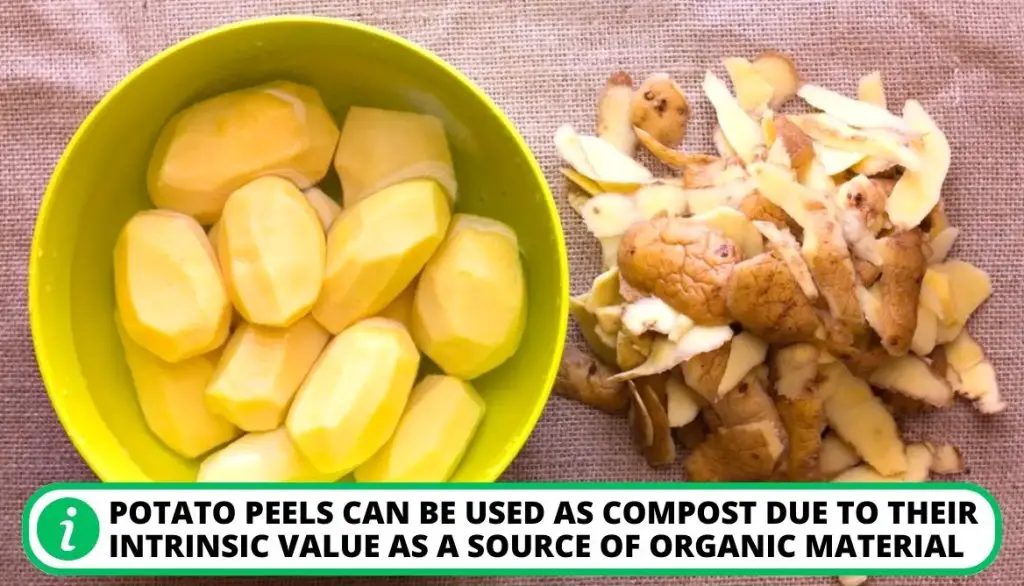
Advantages of Composting Potato Peels
Potato peels boast numerous benefits, although we can only highlight a few here. Observe the advantages of composting them below:
1. Enhancing the Quality of Your Soil
Through composting potato peels, organic matter is introduced into the soil, resulting in improved structure and fertility.
2. Recycling of Nutrients
Potato peels contain vital nutrients such as potassium, phosphorus, and nitrogen. By composting them, these nutrients are returned to the soil, offering a natural and sustainable source of nourishment for plants.
3. Augmented Water Retention
The compost potato peels in the soil aid in moisture retention, thus reducing the frequency of watering and enhancing resistance to drought conditions.

4. Improved Soil Structure
Potato peels assist in loosening compacted soil, thereby promoting aeration and drainage. This is particularly beneficial for root growth and overall plant health.
5. Waste Reduction
Composting potato peels diverts organic waste away from landfills, effectively diminishing the generation of greenhouse gases like methane that are associated with waste decomposition.
6. Serves as Sustainable Gardening Practices
By composting potato peelings and other organic materials, gardeners can adopt eco-friendly practices, minimizing the use of synthetic fertilizers and advocating for a more sustainable approach to gardening.
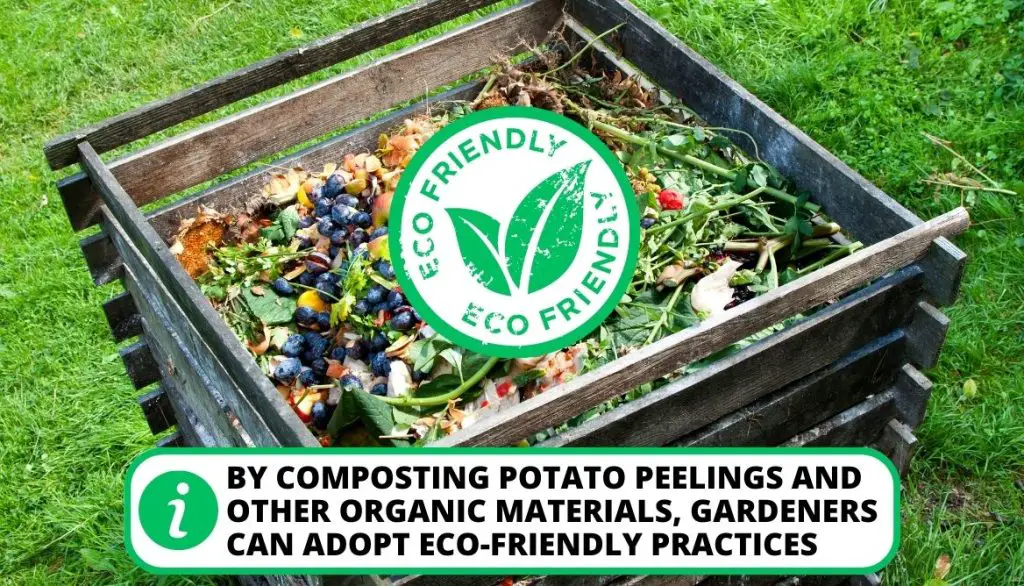
7. Cost-Effectiveness
Composting potato peels at home eliminates purchasing chemical fertilizers, effectively reducing gardening expenses.
8. Beneficial for Organisms
Adding potato peels provides a habitat and food source for beneficial soil organisms, such as earthworms and beneficial bacteria. These organisms contribute to the creation of healthy soil ecosystems and facilitate nutrient cycling.
9. Disease and Pest Suppression
Healthy soil resulting from the composting of potato peels can aid in the suppression of certain plant diseases and pests. This promotes overall plant vigor and diminishes the need for pesticides.
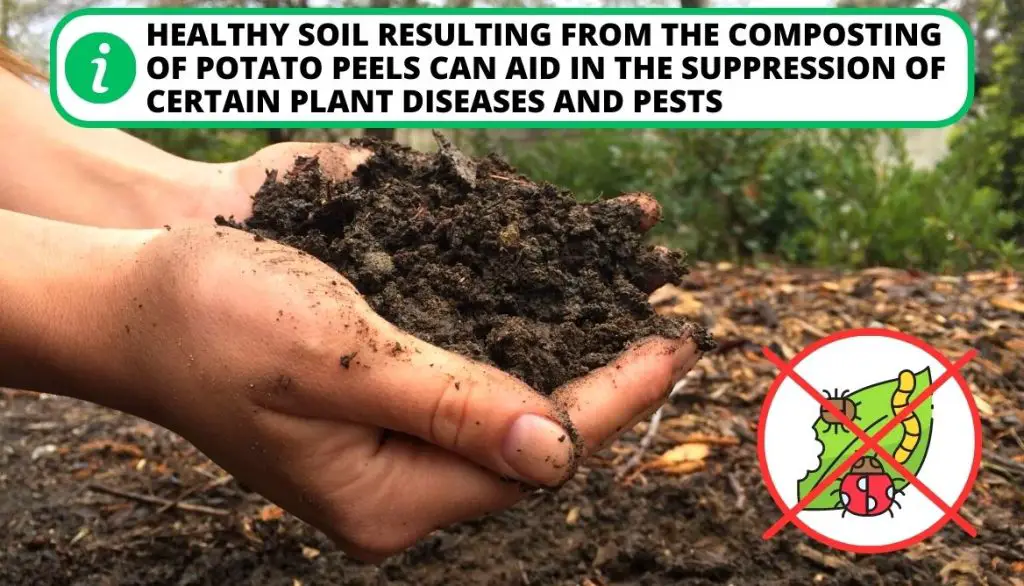
10. Carbon Sequestration
Compost potato peels in the garden aid in the sequestration of carbon in the soil. This contributes to climate change mitigation by reducing greenhouse gas emissions.
How Long Does It Take for Potato Peels to Compost?
The time it takes for potato peels to degrade in compost can vary depending on a number of variables, including:
- Temperature,
- Moisture content,
- Oxygen availability,
- The compost pile’s general makeup.
Potato peels typically take two to six months to totally deteriorate. Peels from potatoes fall under the category of “green” or nitrogen-rich materials. However, compost potato peels may be slightly delayed because of their starch content, which is substantially larger than that of other kitchen scraps.
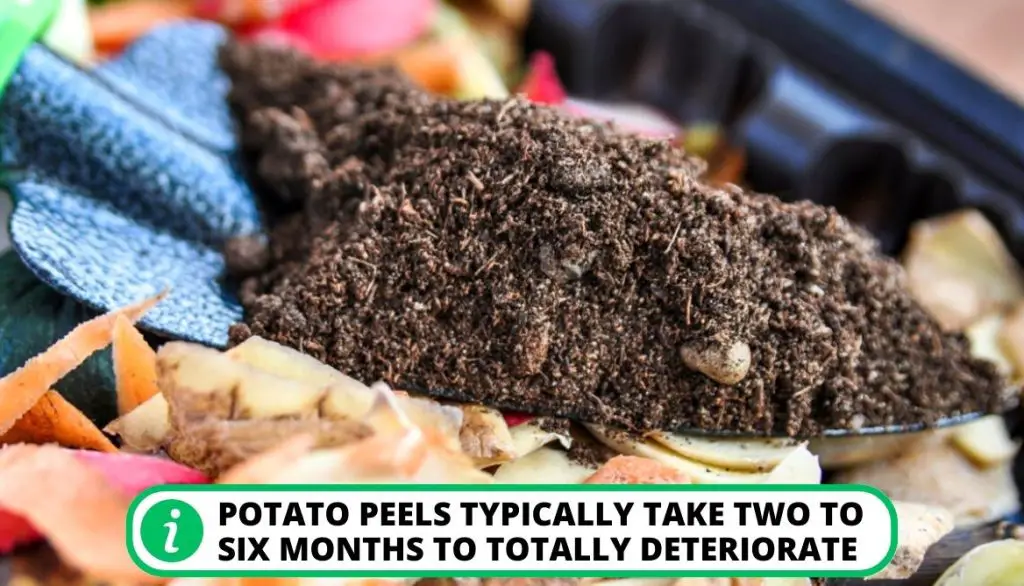
How to Compost Potato Peels?
Composting potato peels serves as an excellent method for waste reduction and the creation of nutrient-rich soil for your garden. Follow these steps to effectively compost potato peels:
Step 1. Thoroughly Cleanse the Potato Peels before Composting
It is crucial to meticulously rinse the peels to eliminate any dirt, debris, or potato blight from forming. This step ensures a clean and odor-free composting process. Proceed to chop or shred the peels into smaller pieces.
Step 2. Get the Compost Container Ready
Select a suitable compost bin or container that aligns with your composting requirements. Options range from traditional compost bins to compost tumblers or even simple piles in your backyard. Ensure that the container has proper drainage and aeration, facilitating composting.
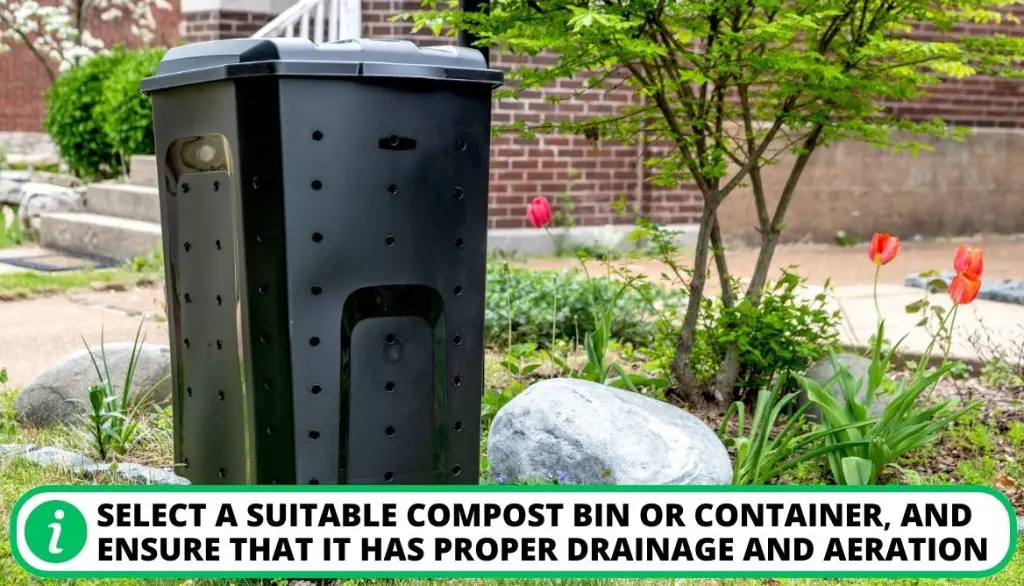
Step 3. Incorporate Brown and Green Materials
To establish a well-balanced compost pile, a mixture of “browns” (carbon-rich materials) and “greens” (nitrogen-rich materials) is necessary.”Brown material” encompass dried leaves, shredded newspaper, or straw, while “green material” consists of food scraps, potato plants remain, and vegetable scraps.
Initiate the layering process by adding a layer of brown at the bottom of your compost bin. This facilitates airflow and moisture absorption, preventing the pile from becoming excessively wet and emitting odors. Aim for a layer that measures approximately 4 to 6 inches in thickness.
Step 4. Continue Layering
On top of the browns, put the greens. You will mix in the potato skins at this point. Ensure a uniform distribution as you sprinkle a thin layer of potato peels over the layer of browns. Then add another layer of brown material to cover the peels.
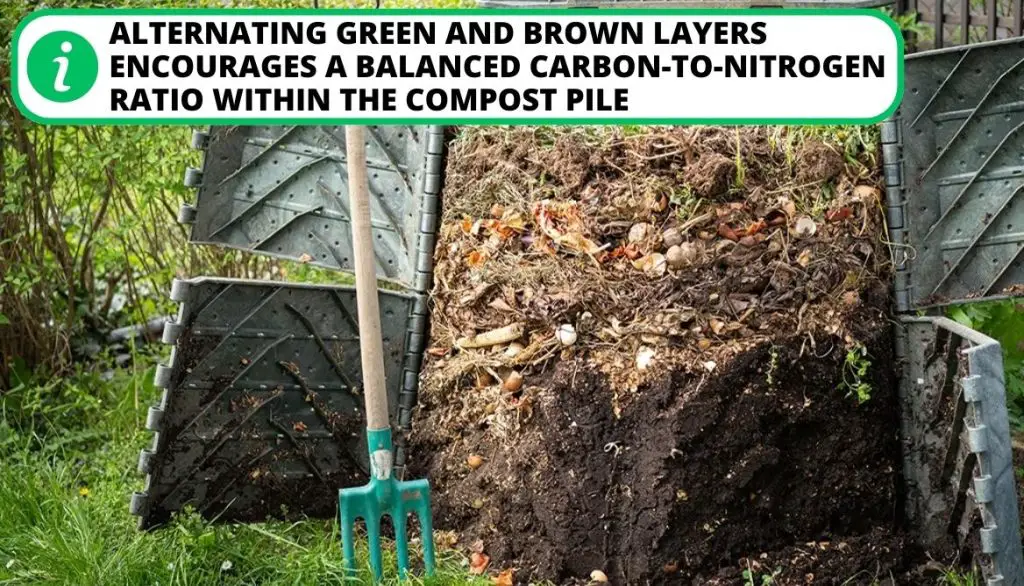
Step 5. Provide Adequate Moisture to the Compost Piles
For your composting to be successful, moisture is necessary. The compost pile should always be wet, about like a sponge that has been wrung out. The compost pile might need water added if the potato peels are fairly dry. As you build the pile, wet each layer with a watering can or hose.
Step 6: Turn the Pile
This action assists in the distribution of moisture, oxygen, and beneficial microorganisms, which hasten the decomposition of potato peels and other organic matter. Additionally, it helps maintain a consistent temperature throughout the pile.
- The optimal temperature range for efficient composting typically falls between 110-160°F (43-71°C).
- However, potato peels alone may not generate enough heat for ideal composting.
- To encourage higher temperatures within the compost pile and avoid potato blight, consider incorporating other nitrogen-rich materials like grass clippings or manure.
- Continue turning the pile every few weeks or when a decrease in temperature or compaction is observed.
- Over time, the potato peels will break down along with the other compostable materials, ultimately transforming into nutrient-rich compost suitable for your garden.
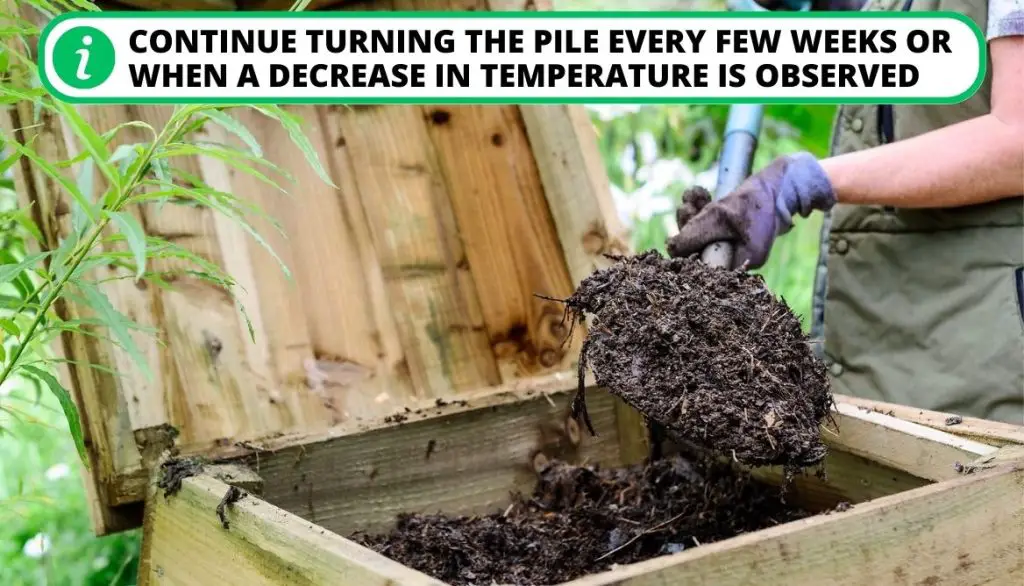
Can You Reuse Your Potato Compost?
The above question is quite familiar to the question “Can you compost potato peels?” To make nutrient-rich compost for gardening and plant culture, it is normal practice to compost organic items like potato peels.
Potato compost is formed by adding potato peels to compost. So, potato compost is recyclable because they are made from natural ingredients.
Do Potato Rinds Contribute Nutrients to Compost?
Potato peel or rinds encompass an array of nutrients that can bestow benefits upon the compost and, ultimately, the cultivated flora therein. Here lie some of the pivotal nutrients inherent in potato rinds and their potential contribution:
1. Nitrogen
Potato peelings contain nitrogen, an indispensable nutrient for the proliferation of plants. Nitrogen aids in the development of verdant, foliage-laden segments of the plant. When potato rinds undergo decomposition within the compost, they liberate nitrogen into the soil, thus enriching it with this vital nutrient.
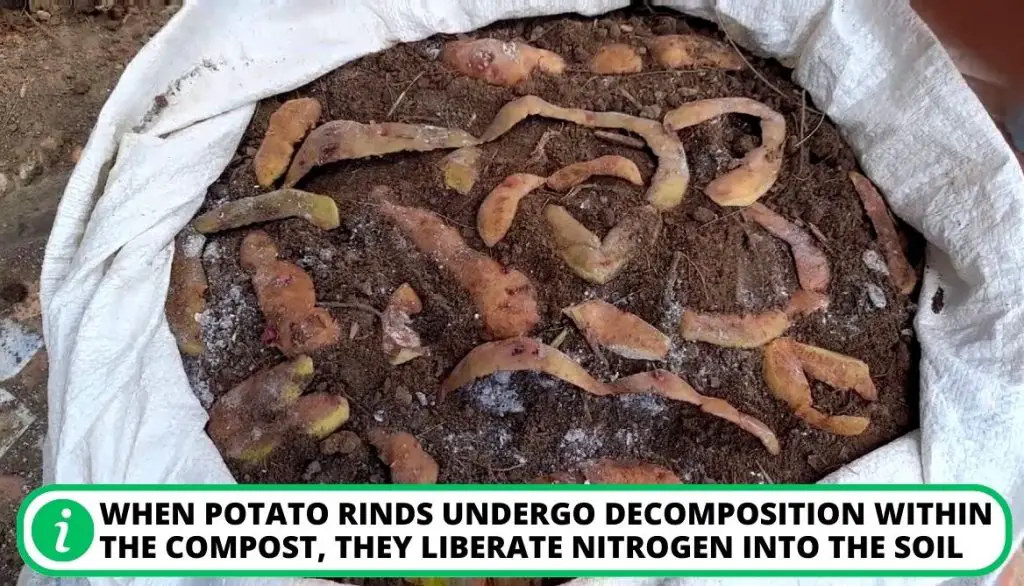
2. Phosphorus
This nutrient holds considerable significance in fostering plant growth, particularly pertaining to root establishment, blossoming, and fruiting. While potato skins may not be overtly abundant in phosphorus, they nevertheless impart meager quantities of this nutrient to the compost during their disintegration.
3. Potassium
This mineral plays a pivotal role in sustaining plant vitality, encompassing augmenting resistance to ailments, bolstering sturdy stems, and amplifying the quality of fruits. Potato rinds harbor potassium, which gradually permeates the compost as they disintegrate.
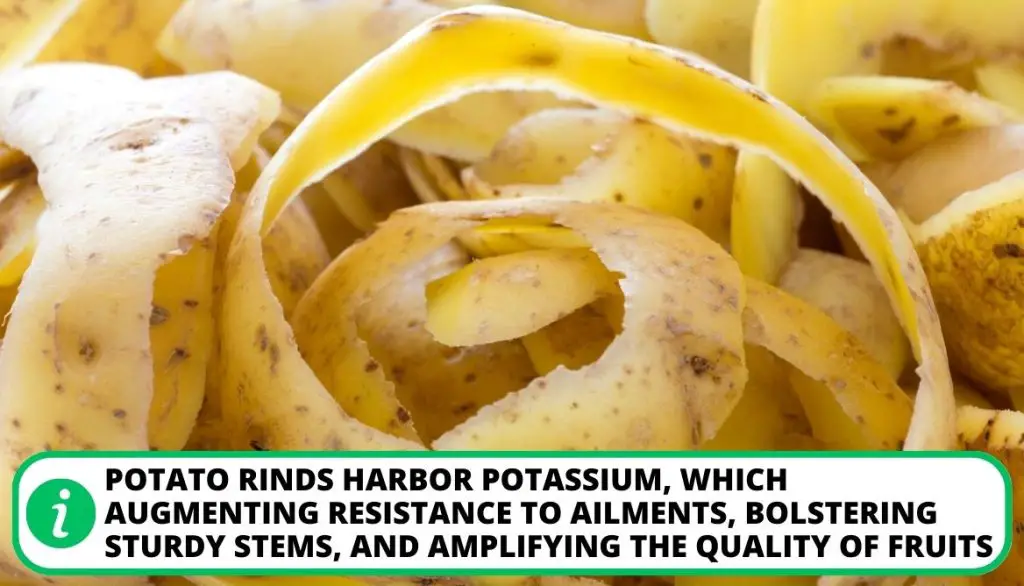
4. Magnesium
This essential mineral facilitates chlorophyll synthesis, an imperative process for photosynthesis in plants. Though potato rinds do not serve as a substantial source of magnesium, they still confer minute amounts of this nutrient upon the compost.
By composting potatoes and incorporating them into your compost heap or bin, you can harness their nutrient content and engender a valuable soil amendment.
Can You Compost Potato Peels From Infected Potato Tubers?
Composting infected potato peel can potentially introduce disease or pests into your compost pile. It’s generally recommended to avoid composting any plant material from infected or diseased plants, including potato peelings from infected potatoes.
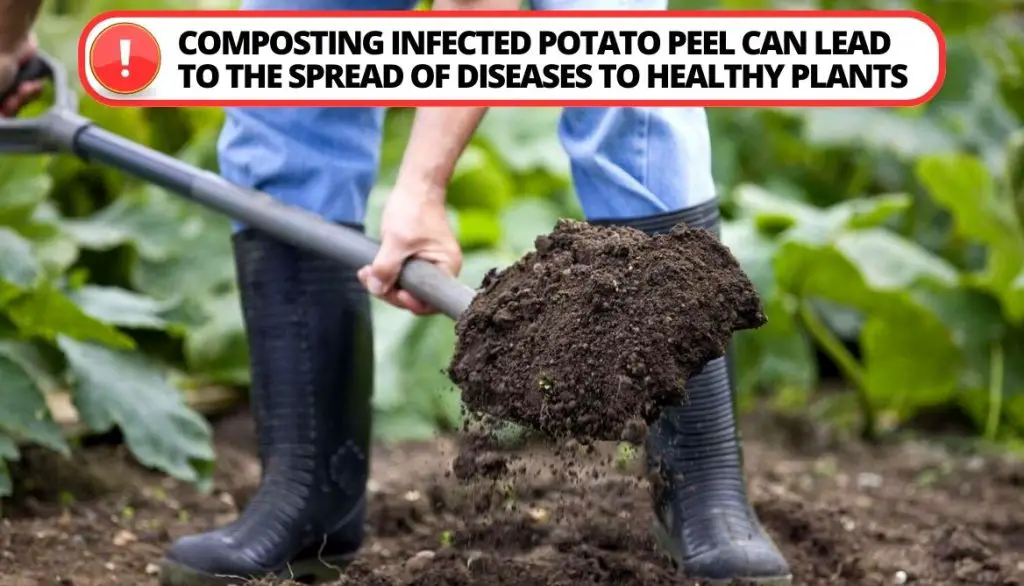
- Diseased plant material may contain pathogens or spores that can survive the composting process and be transferred to your garden when you use the compost.
- This can lead to the spread of diseases to healthy plants.
- For compost potato peels, it’s generally recommended to use healthy, disease-free plant material to ensure the quality and safety of your manure.
- You can consider placing them in a sealed bag and disposing of them in the trash or contacting your local waste management authorities for guidance on proper disposal methods for diseased plant material in your area.
Do Composting Potatoes Result In Potato Blight?
Potato blight, also known as late blight or Phytophthora infestans, is a fungal disease that affects potato crops, causing significant damage to the foliage and tubers.
Composting potatoes, including their peels, can potentially introduce potato blight or other diseases if the compost is not properly managed.
How To Make Fertilizer From Potato Peels
Potato peels can be used as fertilizer aside from composting them. Here’s a simple method to make from potato peel fertilizer:
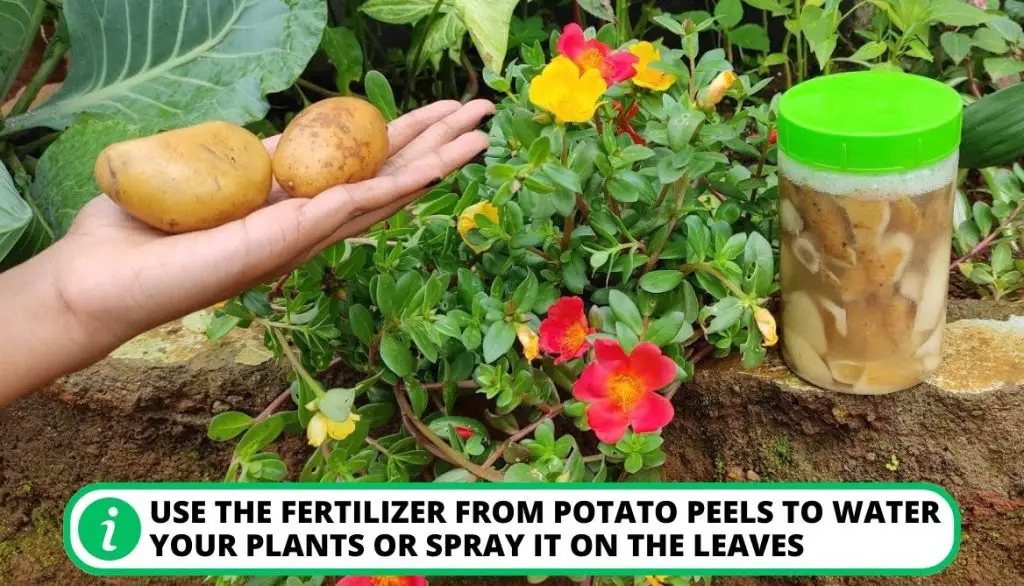
- Collect organic potato peels.
- Dry the peels to prevent potato blight, mold, or rot.
- Grind or chop the peels into smaller pieces.
- Place the peels in a container with a small amount of water.
- Seal the container and let it ferment for 2-3 weeks in a warm, dark location.
- Stir the mixture every few days and check for mold or unpleasant odor.
- Strain the fermented mixture using a sieve or cheesecloth.
- Dilute the liquid fertilizer with water (1 part fertilizer, 3 parts water).
- Use the fertilizer to water your plants or spray it on the leaves, focusing on the root zone.
Remember to test the fertilizer on a small area of your plants before applying it extensively and adjust the concentration or frequency if needed.
FAQ
Are potatoes skins good for composting?
Yes, potato peels prove to be exemplary for composting. They abound in organic matter and harbor valuable nutrients that can profoundly benefit your compost heap.
Are potato skins good for the soil?
Potato skins are beneficial for soil when composted and incorporated. Composted potato skins improve soil structure, moisture retention, and fertility, providing essential nutrients to plants.
Can you put rotten potatoes in compost?
It’s generally not recommended to put rotten potatoes in compost. They may harbor diseases and attract pests. It’s best to discard them in the regular trash or remove them from the compost pile.
How do you make compost with potato skins?
Collect potato skins, chop or shred them, and layer them with other compostable materials in a compost bin or pile. Maintain moisture, turn or mix the bank regularly, and monitor its progress. Once composted, it can be used in the garden.
Do worms eat potato peels?
Yes, worms, especially composting worms like red wigglers (Eisenia fetida), can eat potato peels.
Can you use sweet potato peels for compost?
Yes, you can use sweet potato peels for composting. They are considered organic waste and can provide valuable nutrients to your compost pile.
Conclusion
Composting potato peels offers a range of benefits for both the environment and your garden. Potato peels contain essential nutrients like potassium, phosphorus, nitrogen, and organic matter, making them a valuable addition to your compost pile.
By composting potato peels, you can harness these nutrients and create nutrient-rich soil amendments for your plants, improving soil health and fertility while reducing food scraps.
So will you try to compost potato peels? Leave your answer in the comment section. Thank you.
- How to Get Potatoes to Sprout Eyes: Detailed Growing Guide with 3 Options - July 31, 2023
- Weight of a Medium Potato: Revealed in Detailed Guide - July 29, 2023
- Maris Piper Potatoes: 9 Substitutes You Should Know About - July 27, 2023
Hello! I’m Jessica Zander, a garden coach and consultant based in the Boston area (zone 6b), offering virtual consultations across the country and Canada.
I’ve been passionate about gardening since the early 1990s, and in 2022, I launched You Can Do It Gardening to empower individuals to feel more confident in their gardening endeavors.
Following a 30-year career in nonprofit finance and operations, I transitioned out of that field in mid-June of 2023 due to the growing demand for coaching services. Interestingly, my years of presenting financial statements to boards and finance committees proved to be valuable experience for teaching people about gardening! I enjoy sharing skills, providing guidance and suggestions, and collaborating efficiently with clients to make significant improvements to their outdoor spaces, both small and large. I also regularly teach at the Arlington Continuing Education and Cambridge Adult Education.
My approach is direct and practical, akin to Mary Poppins, but tailored to your garden. Clients find satisfaction in saving money and taking pride in their own gardening achievements.


Add comment